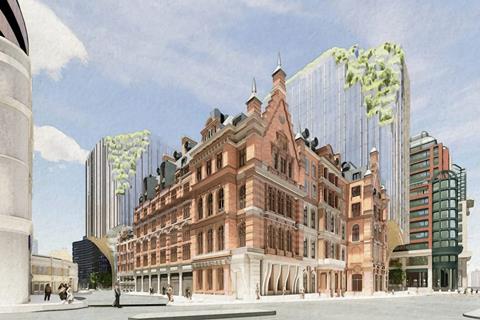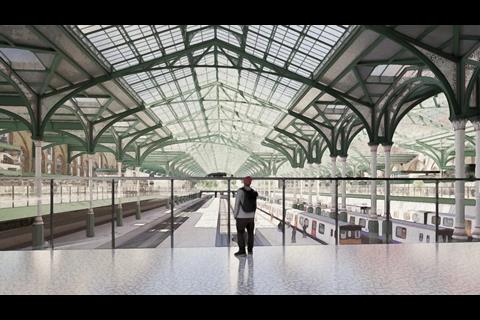- Previous
- Next

Acme's entirely new proposals for Network Rail's redevelopment of Liverpool Street station were unveiled this afternoon



1/4
show captionNetwork Rail has unveiled a “completely reimagined” proposal for the redevelopment of Liverpool Street station designed by Acme, replacing the scheme’s former lead architect Herzog & de Meuron.
Sellar is also understood to no longer be working on the project.
The developer had been Network Rail’s development partner on a set of highly controversial proposals, submitted to the City of London last year, to build a 20-storey office block above the station and the adjacent grade II*-listed former Great Eastern Hotel.
The scheme has been undergoing a substantial redesign for the past six months after its planning application amassed more than 2,000 objections from members of the public and a series of criticisms from heritage bodies including Historic England.
These plans have now been scrapped and Network Rail has launched a consultation on fresh plans which “protect the station’s heritage setting”.
Under Acme’s revised proposals, the cantilevered office tower would be reduced in height from 108m to 97m and set back from the listed hotel “so as not to dominate it in the way it did before”.
No works will be carried out on the hotel building apart from some minor works to adjust how the train shed room meets the hotel, according to the consultation.
Network Rail said the “overall look and feel has been completelyre-imagined, with a design that is more of a signature statement and in keeping with London’s mix of the old and new”.
Changes to a sympathetic 1980s extension to the station building, built in a Victorian style, will be minimised in a stark departure from Herzog & de Meuron’s former proposals, which would have replaced a large section of the station concourse with a series of contemporary white-coloured arches.
Parts of the existing roof above the concourse will instead be replaced by a new roof aiming to “preserve the character and spatial qualities, colour and materials of its predecessor”.
Meanwhile, the concourse itself and the ticket hall would be enlarged with wider gatelines and links to Broadgate and Bishopsgate in order to accommodate increased passenger numbers, which have soared past pre-dovid levels since the opening of the station’s Elizabeth Line platforms.
Changes would include doubling the number of escalators from four to eight, new toilets, step free access across the station and seven new lifts.
Network Rail said the revised plans would be “based on a thorough understanding of the operational needs of the station and its historic significance”.
“The original 1864 station and its 1991 reconfiguration are remarkable for their cathedral-like concourse and train shed, and the new concourse roof extends this language into the 21st century,” the transport operator said.
Network Rail Property’s group property director Robin Dobson added: “Investing in transport infrastructure is key to unlocking future economic growth.
“We’ve spent time talking and listening: our latest plans celebrate Victorian features including the original train shed and the Great Eastern Hotel.
“Network Rail Property is leading a new team with a new approach which will respect the station’s unique heritage - simple in design, embracing London’s mix of the old with the new.
“A new office building on top of the station concourse will generate the money to pay for these improvements.”
Acme founding director Friedrich Ludewig described the scheme as a “monumental design challenge” aiming to avoid heritage damage done to other major London stations.
“Working with Network Rail Property, we are creating a transport hub that will work for the city and all Londoners. The 1990s saw a few stations such as Victoria, Cannon Street and Charing Cross compromised by Over-Station Development,” he said.
“At Liverpool Street, we will retain the sense of a tall and airy concourse, with a flexible workplace building above to fund the development of the station at street level.”
Network Rail’s project team includes Aecom on engineering and transport, Certo as project manager, Gerald Eve on planning, Gleeds as cost manager, Donald Insall Associates on heritage and townscape, GIA on daylight and sunlight and SLA as landscape architect.
The rethink of the scheme over the past six months has involved a much greater level of input from Network Rail, which had previously allowed the Sellar and Herzog & de Meuron-led design team, which also included Scott Brownrigg, to work up the approach for the redevelopment.
Herzog & de Meuron and Sellar have been contacted for comment.

